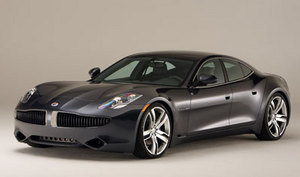2010 Fisker Karma Hybrid Review: Engine, Performance, and Pricing
The gorgeous 2010 Fisker Karma sports sedan promises so much that some auto-industry watchers fear it’s almost too good to be true. The verdict should come with the Karma’s scheduled production debut in late 2009.
Fisker Automotive calls the Karma an eco-friendly car without compromise in performance, style or design. It’s a large, four-passenger plug-in hybrid sedan that drips luxury and sex appeal.
Based in Irvine, California, Fisker Automotive is a small manufacturer
specializing in premium sports cars and plans to produce 15,000 Karma
models a year. The Karma was designed by company founder Henrik Fisker,
a former stylist for BMW and Aston Martin whose credits include modern
classics such as the BMW Z8 and Aston Martin DB9.
The Karma looks more like a sports car than a four-door sedan that
seats four. Its body is made of aluminum and plastic and its roof is an
expansive solar panel that captures the sun’s energy to power
accessories like the climate-control fan. Its front end and grille have
a shark-nose sneer familiar to Aston Martin aficionados, and it’s
low-slung for a sedan, with a wide track, long wheelbase and standard
22-inch wheels. Its exotic bi-Xenon headlight clusters and LED
taillights look like polished gemstones.
Still, the most exotic thing about the Karma might be its powertrain.
It’s not a hybrid like Toyota’s familiar Prius, in which the gasoline
engine can actually deliver power to the car’s drive wheels. The
rear-drive Karma is motivated strictly by two electric motors with a
combined 402 peak horsepower. They’re connected to the differential
without any sort of conventional transmission. Road speed is managed
strictly by varying the speed of the electric motors.
The motors are fed by a lithium-ion battery pack mounted toward the
middle of the car for balance. The batteries can be charged from a
standard 110-volt household outlet, and Fisker claims they’ll give the
Karma a range of at least 50 miles without burning a drop of gasoline.
Roughly 60 percent of all drivers travel less than 50 miles per day.
Theoretically, at least, many could commute in the Karma with nothing
more than an overnight charge.
Still, the Karma’s Q-Drive powertrain, developed with a company called
Quantum Technologies, does have a gasoline engine: an efficient,
turbocharged 2.0-liter four-cylinder, provided by General Motors,
generating 260 horsepower. The gas engine is mated to a compact
generator under the hood, and generates electricity to charge the
battery pack. Fisker says the Karma’s fuel tank will be large enough to
give it a minimum 300-mile range between fuel stops, in the absence of
any plug-in charging.
Equipped with the Q-Drive powertrain, the Karma will travel from 0 to
60 mph in an impressive 5.8 seconds, according to Fisker, with a top
speed of 95 mph in plug-in mode and 125 mph in gas engine/generator
mode.
The Karma measures 200 inches in length with a wheelbase of 126.4
inches, or nearly as big as a full-size Mercedes-Benz S-Class sedan.
Yet its roof is far lower than the typical large sedan’s. It’s built on
an aluminum space frame, like high-tech exotic sports cars. With its
obvious low center of gravity and massive tires, it may handle
something like a big sports car.
Its interior definitely has the feel of a specialty car. The door
openings are relatively small, so getting in and out is not
particularly easy, especially for a sedan. Once inside, however, we
found the seats excellent and cabin space more than adequate, even in
the slow-slung rear seat.
The cabin has the bespoke feel of very expensive cars, with tight,
heavy leather just about everywhere. Fisker calls the finish
sustainable and accountable design, applying reusable materials
enhanced with modern technology. The wood trim, for example, is sourced
from non-living trees collected after forest fires or from lake
bottoms. Most controls are concentrated in a 10.2-inch LED touch screen.
All Karmas will be built with the standard array of airbags and active
safety features, including advanced anti-lock brakes and dynamic
stability control, in one of three trim levels:
Eco ($87,900), EcoSport ($94,900) and EcoChic ($104,900). EcoChic is
animal free, according to the company, with Bamboo Viscose textile
upholstery and trim made from fossilized leaves embedded in glass.
Federal tax credits could essentially lower the prices up to $7,500.
Fisker Automotive says it has already signed 22 dealers, and expects to
have 40 when Karma sales begin near the end of 2009. The company is
based in Irvine, California, with a technical center in Pontiac,
Michigan. The Karma will be manufactured in Finland by the Valmet
Automotive coachworks, which also assembles cars for Porsche.
On Sale: Fall/Winter 2009
Expected Pricing: $87,900-$104,900

